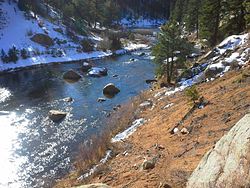This article needs additional citations for verification. (January 2011) |
| South Platte River[1] | |
|---|---|
 South Platte River in Douglas County, Colorado | |
 | |
| Native name | Wašíŋ Wakpá (Lakota) |
| Physical characteristics | |
| Source | |
| • location | Confluence of South Fork and Middle Fork |
| • coordinates | 39°00′40″N 105°44′25″W / 39.01111°N 105.74028°W |
| Mouth | |
• location | Confluence with North Platte River |
• coordinates | 41°06′50″N 100°40′33″W / 41.11389°N 100.67583°W |
• elevation | 2,762 ft (842 m) |
| Length | 439 mi (707 km)[2] |
| Discharge | |
| • average | 174 cu ft/s (4.9 m3/s) |
| Basin features | |
| Progression | Platte—Missouri—Mississippi |
| Discharge range | 0 to 4,640 cu ft/s (0 to 131 m3/s)[3] |
 | |



The South Platte River is one of the two principal tributaries of the Platte River. Flowing through the U.S. states of Colorado and Nebraska, it is itself a major river of the American Midwest and the American Southwest/Mountain West. Its drainage basin includes much of the eastern flank of the Rocky Mountains in Colorado, much of the populated region known as the Colorado Front Range and Eastern Plains, and a portion of southeastern Wyoming in the vicinity of the city of Cheyenne. It joins the North Platte River in western Nebraska to form the Platte, which then flows across Nebraska to the Missouri. The river serves as the principal source of water for eastern Colorado. In its valley along the foothills in Colorado, it has permitted agriculture in an area of the Colorado Piedmont and Great Plains that is otherwise arid.
- ^ "South Platte River". Geographic Names Information System. United States Geological Survey, United States Department of the Interior. Retrieved 2011-01-29.
- ^ U.S. Geological Survey. National Hydrography Dataset high-resolution flowline data. The National Map, accessed March 25, 2011
- ^ Water Data Report, Colorado 2003, from Water Resources Data Colorado Water Year 2003, USGS.